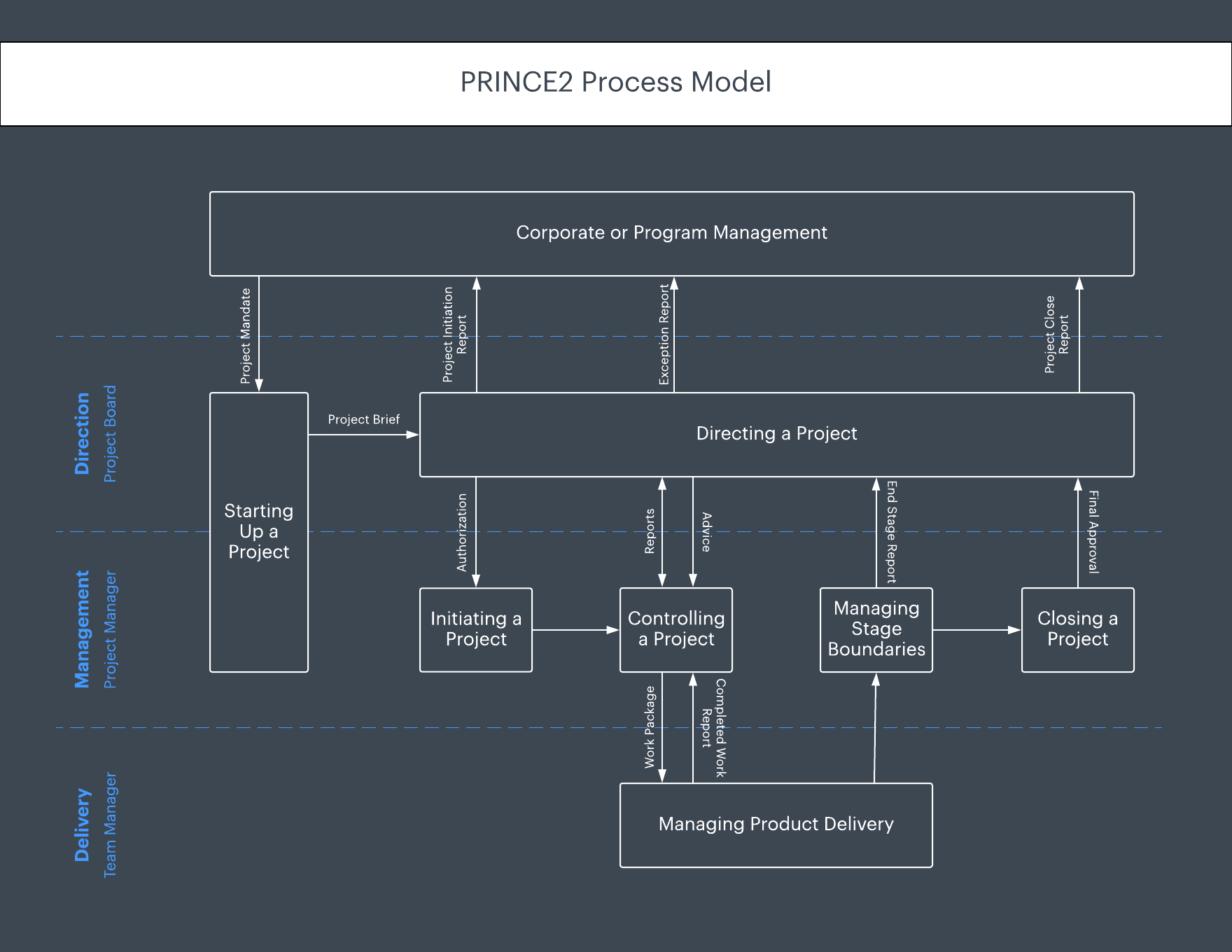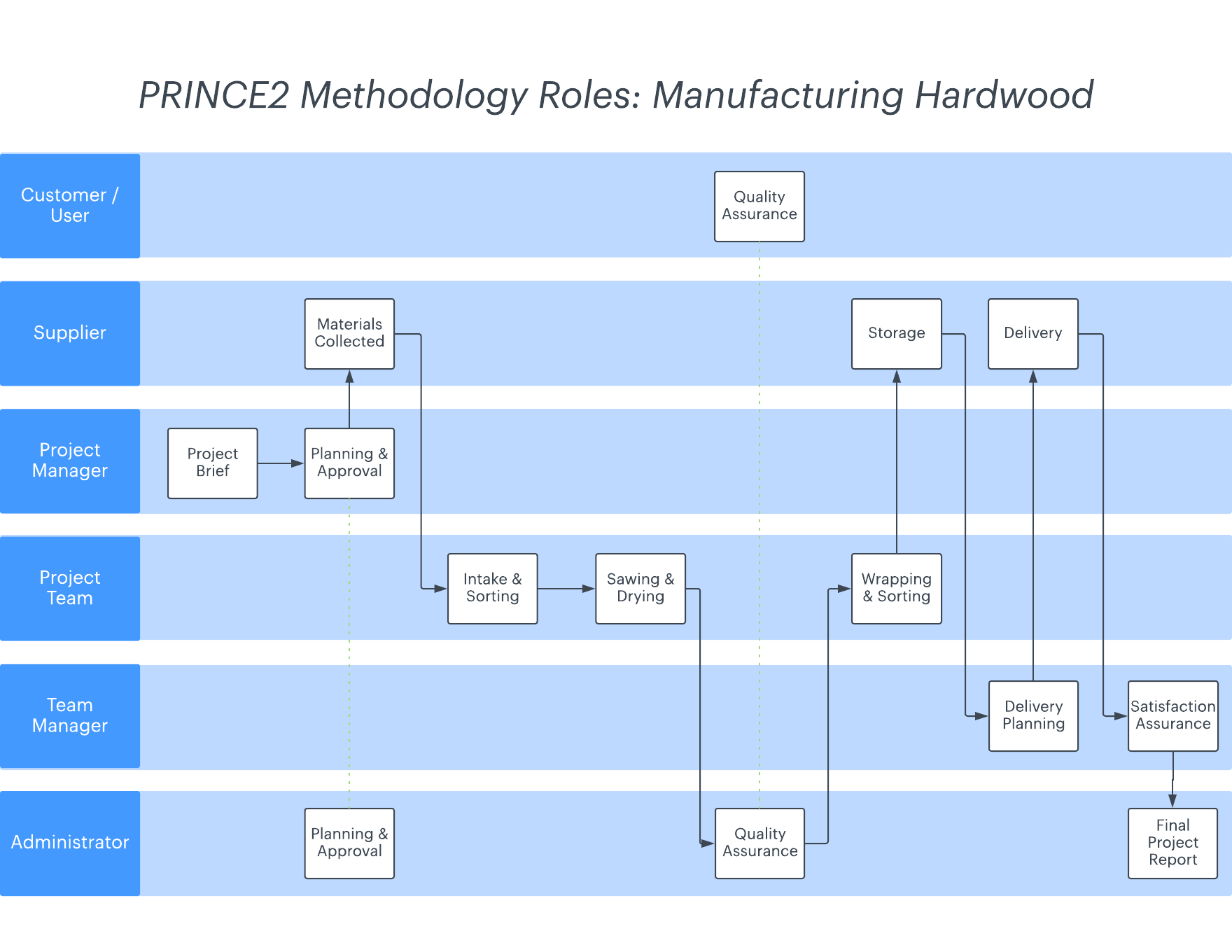
What Is PRINCE2 Methodology?
Lucid Content
Reading time: about 5 min
Colin Bentley, in his book PRINCE2: A Practical Handbook, asks a perfectly reasonable question: “Why do so many professionals say they are project managing, when what they are actually doing is firefighting?”
The job of a project manager can quickly become one of disaster recovery if you don’t have a process in place to complete projects efficiently. And as you research different process improvement methodologies, you might want to consider PRINCE2, an approach constructed in 1989 by Central Computer and Telecommunications Agency and currently used by the UK Government.
PRINCE2 is an acronym which stands for PRojects IN Controlled Environments. (The original PRINCE methodology was updated in 1996, hence the “2.”) Its framework requires projects to have organized and controlled starts, middles, and ends.

7 principles of PRINCE2 methodology
You’ll quickly see that seven is the magic number in this methodology. PRINCE2 follows seven basic principles:
1. Projects must have a continued business justification
Throughout the project (not just at the beginning), you should think about the project’s return on investment. Determine whether the benefits outweigh the cost and risk and how likely it is that the project will result in those benefits.
2. Teams should learn from experience
Teams keep a lessons log, where they report lessons learned from their projects and avoid repeated mistakes.
3. Roles and responsibilities need to be clearly defined
Everyone involved in the project should understand their responsibilities and the responsibilities of others. We’ll talk more about roles within PRINCE2 methodology in a moment.
4. Work is planned and managed in stages
PRINCE2 breaks a project up into more manageable stages. At the end of each stage, teams can record lessons learned and evaluate whether the project is on track.
5. Manage the team by exception
The project board (senior managers) initially determines time, cost, and other project requirements and then leaves day-to-day management to the project manager. If issues arise that impact the requirements, the project manager would inform the board.
6. Stay focused on the products
The team should always focus on meeting project requirements and keeping the quality high.
7. Tailor this approach to meet project requirements
You don’t have to live PRINCE2 to the letter. Adapt the method based on the size of the project, the size of your team, etc.
The PRINCE2 method allows for better control of resources and better business and project risk management. PRINCE2 identifies who should be involved in the project and in what capacity. If a project does not adhere to these basic principles, then PRINCE2 is not the right way to manage the project.
PRINCE2 processes
In keeping with the seven steps, there are seven different stages of a PRINCE2 project.
1. Starting up a project
Create a project mandate that includes a brief explanation of achievable goals and the necessity of the project. Have the mandate assessed. If approved, create a more detailed project brief.
2. Directing a project
The project board discusses the expanded project brief. If it's approved, they then identify all needed resources and delegate to the project manager.
3. Initiating a project
The project manager creates a plan and timeline for the project. They include checkpoints for six targets: time, cost, quality, scope, risk, and benefits.
4. Controlling a project
Divide the project into smaller tasks and assign them to the team manager and project team. The project manager will monitor progress and make changes as needed.
5. Managing product delivery
Compare the project’s progress to the original project brief. Review completed project tasks. The project board will then give approval.
6. Managing stage boundaries
The project board and manager review every stage of the project for quality and adherence to the plan. The review is a chance for the project board to decide to move to the next stage of the project or pause progress altogether.
7. Closing a project
The project board will give final approval once deliverables are met. The project manager will complete any remaining documentation and reporting.
7 roles of PRINCE2 methodology
There are three primary roles within a PRINCE2 method project: the project manager, the project team, and the project board. The project board consists of the customer, the end user, and the supplier.
In addition to these principal roles, support roles are an integral part of project completion:
- The customer: Whoever is paying for the project.
- The user: Anyone who will use deliverables or will become impacted by the project’s outcome. In some instances, the user and the customer could be the same individual.
- The supplier: An expert whose knowledge and skills are needed to create the final product.
- The project manager: The individual who organizes the projects, delegates work/assignments, and keeps the project on schedule.
- The project team: The group that does the actual work and completes project tasks.
- The team manager: The leader of the project team and reports to the project manager.
- The administrator: Owns all documentation, meeting schedules, and overall project facilitation. Depending on the size of the project, the admin role could be assumed by the project manager.
Use our swimlane process map template in Lucidchart to help your team understand roles and responsibilities.

Types of PRINCE2 method documentation
Keep detailed records throughout the life of a project. Use them to check deliverables, report/communicate to the project board, and serve as a roadmap for when and where to make changes.
- Business case: A document that explains why the project is necessary and what benefits end users can anticipate.
- Risk register: A stock of potential risks, their probability to occur, and anticipated impact.
- Quality register: A record of quality assurance checks performed during the project.
- Issues register: A running log of concerns and/or problems observed by project team members.
- Lessons log: An account of lessons learned from the project that could be applied to future projects.
- Daily log: A daily record kept by the project manager detailing project progress and activity.
Applying PRINCE2
The best way to fully understand PRINCE2 methodology is to apply the steps to a project of your own. Various PRINCE2 training, qualification, and certificates are available. Frequent process review throughout the life of a project leads to stronger results.
Lucidchart has customizable templates that relate to PRINCE2. Use them to help your team understand the PRINCE2 project management process.
About Lucidchart
Lucidchart, a cloud-based intelligent diagramming application, is a core component of Lucid Software's Visual Collaboration Suite. This intuitive, cloud-based solution empowers teams to collaborate in real-time to build flowcharts, mockups, UML diagrams, customer journey maps, and more. Lucidchart propels teams forward to build the future faster. Lucid is proud to serve top businesses around the world, including customers such as Google, GE, and NBC Universal, and 99% of the Fortune 500. Lucid partners with industry leaders, including Google, Atlassian, and Microsoft. Since its founding, Lucid has received numerous awards for its products, business, and workplace culture. For more information, visit lucidchart.com.
Related articles
Everything You Need for Successful Critical Chain Project Management
Looking for strategies that drive timely, cost-effective project completion and don’t overwork your team? Learn critical chain project management methodology and how it differs from critical path methodology.
Which process improvement methodology should you use?
Struggling to decide which process improvement methodology to use? Learn about the top approaches—Six Sigma, Lean, TQM, Just-in-time, and others—and the diagrams that can help you implement these techniques starting today.
